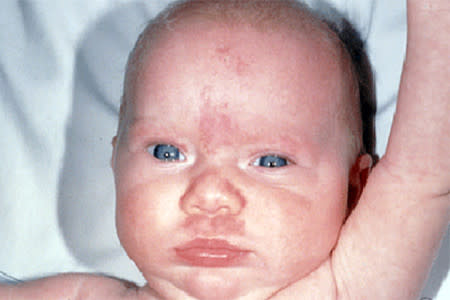Birthmarks: Overview
What exactly is a birthmark?
If your baby has a birthmark, you’ll likely see a spot, patch, or lump that looks different from the rest of your baby’s skin. You may see this when your baby is born. Some birthmarks appear shortly after birth.
Birthmarks come in many shapes and colors. You may see a flat or raised mark. It may the size of a pinhead or cover a large area of your child’s skin. Most birthmarks fall somewhere in between. A birthmark can be pink, red, tan, brown, or any other color. Some look like a bruise. Others look like a stain on the skin.
Some birthmarks are common. It’s estimated that between 3% and 10% of babies are born with a type of birthmark called a hemangioma. Other birthmarks, such a port-wine stain, are less common.
Salmon patches
This harmless birthmark will fade with time and tends to be most noticeable when your baby cries or becomes too warm.

Certain types of birthmarks, such as a salmon patch or hemangioma, often fade on their own. Others, such a mole, tend to remain on the skin for life.
Yes, a mole is a birthmark when a baby is born with it, or it appears on the skin shortly after birth.
View pictures of different birthmarks
Why a dermatologist should examine your baby’s birthmark
One thing that most birthmarks have in common is that they’re harmless. Yet, if you see a birthmark on your child’s skin, it’s wise to have a dermatologist examine it.
What you think is a birthmark could be the first sign of a skin disease.
It’s also possible that your baby has a harmless birthmark that will grow quickly. Seeing a birthmark grow quickly can be scary. Knowing this will happen and learning what to watch for can help put your mind at ease.
Some birthmarks are a sign that something is going on inside your baby’s body.
By making an appointment with a board-certified dermatologist as soon as you notice the birthmark, you’ll know what to expect. A dermatologist can also tell you whether treatment is recommended, be it a birthmark or skin condition.
Related AAD resources
Image
Image used with permission of the American Academy of Dermatology National Library of Dermatologic Teaching Slides.
References
American Academy of Dermatology, “Red, white and brown: Defining characteristics of common birthmarks will determine type and timing of treatment.” News release issued Feb 4, 2011.
Anderson KR, Schoch JJ. “Increasing incidence of infantile hemangiomas (IH) over the past 35 years: Correlation with decreasing gestational age at birth and birth weight.” J Am Acad Dermatol. 2016 Jan;74(1):120-6.
Del Pozzo-Magana B, Dizon M, et al. “Newborn skin disease, Part 1: Birthmarks.” In: Society for Pediatric Dermatology and the American Academy of Dermatology’s Basic Dermatology Curriculum. Peer review by: Maguiness S. May 2016.
 Atopic dermatitis: More FDA-approved treatments
Atopic dermatitis: More FDA-approved treatments
 Biosimilars: 14 FAQs
Biosimilars: 14 FAQs
 How to trim your nails
How to trim your nails
 Relieve uncontrollably itchy skin
Relieve uncontrollably itchy skin
 Fade dark spots
Fade dark spots
 Untreatable razor bumps or acne?
Untreatable razor bumps or acne?
 Tattoo removal
Tattoo removal
 Scar treatment
Scar treatment
 Free materials to help raise skin cancer awareness
Free materials to help raise skin cancer awareness
 Dermatologist-approved lesson plans, activities you can use
Dermatologist-approved lesson plans, activities you can use
 Find a Dermatologist
Find a Dermatologist
 What is a dermatologist?
What is a dermatologist?